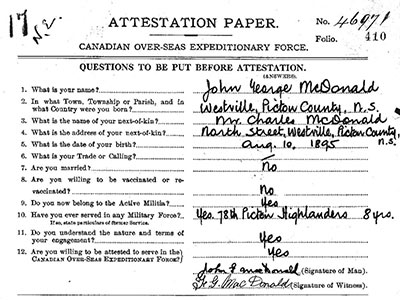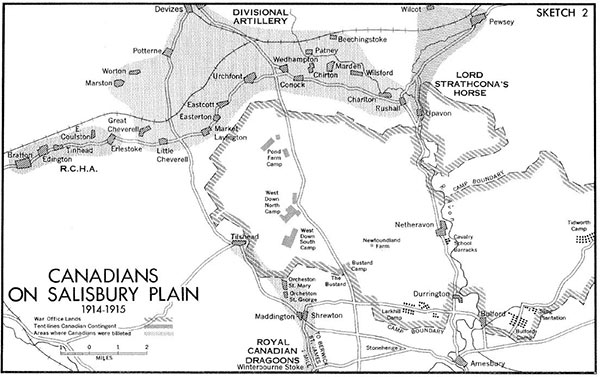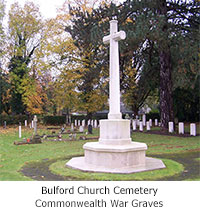First Local Victim of the Great War Private John George MacDonald
As in all wars disease takes a heavy toll among soldiers and civilians alike. The First World War was no exception. Conditions on Salisbury Plain, where the Canadian Expeditionary Force trained, were less than ideal over the winter of 1914/1915. Heavy rains and cold temperatures made short work of flooded tents and poor-quality uniforms and boots. It also took a toll on the respiratory health of many of the men.
 The first man of the 78th Pictou Highlanders to die overseas was 19 year old Bugler Private John George MacDonald. Private MacDonald grew up on North Street, Westville, born August 10, 1895, the son of Mr. and Mrs. Charles MacDonald. Like many boys of the time, as Canada’s defense rested mainly with volunteer local militias, he joined the 78th Pictou Highlanders about the age of 11. After war was declared by Great Britain he volunteered to serve overseas. His attestation papers describe him as 5 feet 9 ¾ inches tall, of fair complexion with hazel eyes and black hair. His religion was Presbyterian. With usual precision the attestation papers mention a “stub of a forefinger” on his left hand.
The first man of the 78th Pictou Highlanders to die overseas was 19 year old Bugler Private John George MacDonald. Private MacDonald grew up on North Street, Westville, born August 10, 1895, the son of Mr. and Mrs. Charles MacDonald. Like many boys of the time, as Canada’s defense rested mainly with volunteer local militias, he joined the 78th Pictou Highlanders about the age of 11. After war was declared by Great Britain he volunteered to serve overseas. His attestation papers describe him as 5 feet 9 ¾ inches tall, of fair complexion with hazel eyes and black hair. His religion was Presbyterian. With usual precision the attestation papers mention a “stub of a forefinger” on his left hand.
Along with the other men of the 78th he left Pictou County August 20, 1914 after marching out from New Glasgow to Westville, through Stellarton, and back to New Glasgow. Before leaving the men were provided a reception by Miss (Dr.) Caroline Carmichael, who along with other dignitaries wished them “God-speed”. The 78th was transported by train from New Glasgow to Quebec City where they undertook preliminary training at the newly constructed Camp Valcartier. Valcartier was the marshalling point for much of the militia contingent of the Canadian Expeditionary Force.
By the time the initial training was complete the 78th had been merged into the promised Nova Scotia Battalion, the 17th (which was broken up before reaching France, much to the disappointment and anger of the 78th Pictou Highlanders). Private MacDonald and his Pictonian comrades boarded the SS Ruthenia and the convoy of 31 ships was ready to sail October 1, 1914. Upon reaching open ocean they were joined by two other ships, one carrying members of the British 2nd Lincolnshire Regiment; the other the Newfoundland Contingent. With protection from British warships the crossing took 12 days with all ships arriving safely in Plymouth, England.
The Canadian Expeditionary Force was assigned to train on historic Salisbury Plain, the camp being just north of the prehistoric monument Stonehenge. By all accounts the weather was terrible with record amounts of rainfall, high winds, and cold temperatures. The men slept in tents, which combined with bad weather, contributed to unhealthy conditions. Private MacDonald and the men of the 17th Battalion were eventually assigned to the barracks of the newly constructed Sling Plantation – Camp Bulford just north of the town of Amesbury.

 By late December Captain W.B. Coulter of the 17th transferred Private MacDonald to the isolation ward at Sling Plantation. His condition did not improve and he was transferred 3 miles north to Netheravon House, Netheravon, which had been made over to a military hospital. He was diagnosed with bronchial pneumonia. Private John George MacDonald died in hospital at 7:30 pm January 2, 1915.
By late December Captain W.B. Coulter of the 17th transferred Private MacDonald to the isolation ward at Sling Plantation. His condition did not improve and he was transferred 3 miles north to Netheravon House, Netheravon, which had been made over to a military hospital. He was diagnosed with bronchial pneumonia. Private John George MacDonald died in hospital at 7:30 pm January 2, 1915.
Sources:
- Cameron, James M. “Pictonians in Arms”. University of New Brunswick and the author: Fredericton, NB, 1969. Available in library 971.613 CAM and online //novastory.ca/cdm/compoundobject/collection/picbooks/id/10244/rec/12
- Commonwealth War Graves Commission. “War Dead and Cemetery Records”. //www.cwgc.org
- “Eastern Chronicle August 21, 1914”. [Newspaper] Microfilm located in the New Glasgow Library.
- “Freelance January 17, 1915”. [Newspaper] Microfilm located in the New Glasgow Library.
- Library and Archives Canada. “Soldiers of the First World War 1914-1918. Military Records”. //www.bac-lac.gc.ca/eng/discover/military-heritage/first-world-war/first-world-war-1914-1918-cef/Pages/canadian-expeditionary-force.aspx
- Nicholson, G.W.L. “Official History of the Canadian Army in the First World War: Canadian Expeditionary Force 1914-1915”. Queen’s Printer: Ottawa, 1962. //www.cmp-cpm.forces.gc.ca/dhh-dhp/his/docs/CEF_e.pdf
View a copy of this information sheet in PDF format.
